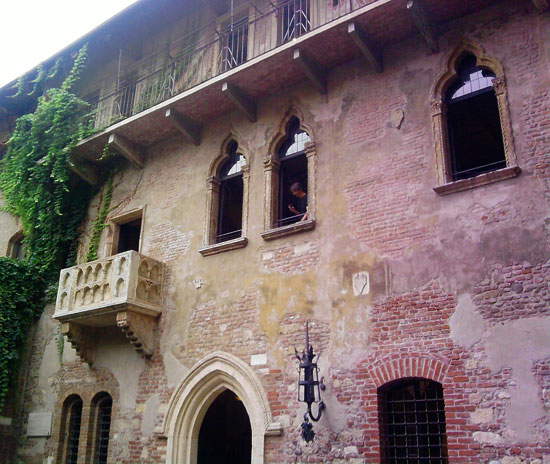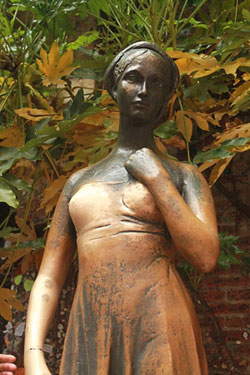The romantic charm of Juliet's house in Verona
O Romeo, Romeo, wherefore art thou Romeo?
Deny thy father and refuse thy name;
Or if thou wilt not, be but sworn my love
And I’ll no longer be a Capulet. [Act II; Scene II]
[Oh Romeo, Romeo, wherefore art thou Romeo?
Deny thy father, refuse thy name;
Or if thou wilt not, swear thou lovest me
And I’ll no longer be a Capulet].
Everyone will know the famous balcony scene depicted in Romeo and Juliet, the Shakespearean tragedy composed between 1594 and 1596.
And it is impossible not to remember this scene when one finds oneself in the very courtyard overlooked by the most famous balcony in English literature: we are in Verona and precisely in the small courtyard of what is traditionally considered Juliet’s house.
According to legend, in fact, this is precisely the birthplace of the daughter of the Dal Cappello family, from which the Capulets surname of the tragedy was derived, in the Verona ruled by the Della Scala family. The Dal Cappello family would be well represented by the coat of arms depicting precisely a hat, placed above the inner arch of the entrance courtyard to the house of the same name.
As with any legend, an aura of mystery and magic is created around it, since there are no true records concerning the real existence of the Capulets and thus of the unhappy story of the two lovers, but I still like to immerse myself in the places of the story of Romeo and Juliet to retrace the scenes narrated by the famous English playwright in his literary work of the same name. Therefore, I don’t feel like being picky and deciding a priori not to go see Juliet’s house just because it doesn’t represent historical evidence; whenever I happen to visit wonderful Verona, I always tend to step into Juliet’s inner courtyard :) Walking through the streets of Verona, one encounters splendid and very important artistic beauties, but I almost never give up the fascination that emanates for me that house, which recalls the unhappy but eternal love story of two lovers, whose love overcame even death (maybe I am an incurable romantic? ;) ).
 |
| Juliet’s house in Verona |
However, I agree with those who would fully avoid the inscriptions of thousands of lovers sealing their love with little hearts and names on the entrance walls leading to the courtyard; I personally find it meaningless. Just take a picture to immortalize the moment we were here with our better half, right?
 |
| The statue of Juliet |
In addition to the pairs of names or initials surrounded by a little heart, there is another tradition for which Juliet herself pays the price, more precisely the right breast of the statue depicting her, placed in the same courtyard, made by Nereo Costantini in 1969: in fact, tourists are used to touch her breast because it seems to bring good luck!
What we see in the courtyard, however, is a copy of the original that is instead inside the house, which can still be visited. The rooms inside show frescoes depicting the story of Romeo and Juliet accompanied by excerpts from Shakespeare’s tragedy, and even the bed and costumes that were used during the filming of Franco Zeffirelli’s film of the same name in 1968. In a multimedia room where images and news about the places related to the two lovers are presented, it is even possible to send letters to Juliet; this probably inspired the plot of Letters to Juliet, the film released in 2010, where the protagonist finds a letter hidden in a cavity in the wall of Juliet’s house written fifty years earlier by an English woman and decides to reply to her.
Entering Juliet’s house is like experiencing as a spectator the most famous scene of Shakespeare’s tragedy: that balcony exudes an indescribable romantic charm for all lovers and especially for those who have loved Shakespeare’s great work as readers.
Warning: the translation into English of the original Italian article was created using automatic tools. We undertake to review all articles, but we do not guarantee the total absence of inaccuracies in the translation due to the program. You can find the original by clicking on the ITA button. If you find any mistake,please contact us.


























